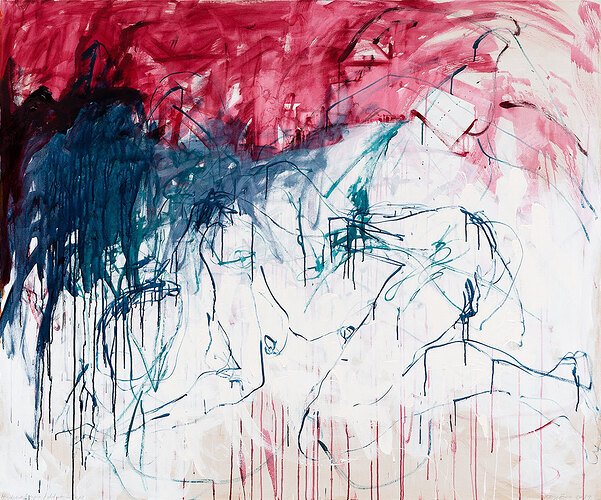Thanks for the comments - feedback is always of great interest - I wouldn’t normally provide explanations for my paintings, as I’m not really into that, but I did want to try to respond to Stella’s question. I am a great believer in letting people see what they want to see in a painting, as that’s what I also appreciate. Sometimes I do wish that I had a more consistent style, but I do seem to continue producing pretty contrasting pieces - looking at the two pieces that I’ve shared, even I find it hard to believe that they came from the same person - I guess variety is the spice of life 
Actually I find the two paintings very similar in many respects! The main difference is in orientation and to a lesser extent palette. An interesting formalist experiment would be to rotate each painting through 90° and then look at them afresh.
That’s not necessarily desirable and certainly not something to consciously strive for, because if you do that, you’ll probably end up repeating yourself and stifle your development.
An interesting point re orientation, as a friend actually preferred painting 2 in landscape format, which I really had problems getting to grips with, perhaps as it had more meaning to me as a figure and therefore more relevant to be vertical as shown.
I think if I was more consistent, at least the theme running through my house would be more constant rather than the haphazard painting styles that fill the walls 
When you look at the paintings, would you say they look amateurish or could you be convinced that they came from someone with painting experience - intrigued to know.
Sorry, but i wouldn’t go there without seeing the work. Just do it and be true to yourself. In one sense, it doesn’t matter what it looks like, what’s important is what it ‘is’ to you (whatever that may be!)
My last piece of advice would be to look first hand at lots of paintings by artists who have influenced you, ie. not in reproduction, but in galleries. The sort of painting that you’ve posted needs to be informed by looking at the really good stuff - mainly American, but also CoBrA - currently showing in Rodez).
Unfortunately in regional French galleries there are many, derivative and weak gestural abstract paintings, usually in primary colours, usually in acrylic (acrylic paint wasn’t invented for that sort of painting and when used in that way instead of oil, it’s like plastic against leather).
Lastly, beware of provincial French artists who seem to have put more effort into refining their signature than into developing their art.
I have visited many museums and galleries over the years and seen a great many original works, as it is a passionate hobby of mine. And Rodez, that’s was the home of Soulages wasn’t it? Very interesting artist.
One of the last visits that I made to one of my favorites, The Royal Academy of Arts was to see a Tracey Emin exhibition - I wasn’t terribly keen on her before the exhibition but came away with a totally different feeling, and now have two books of her work 
I think it still is!
Soulages is an interesting artist for many reasons, perhaps most notably that he is now a centurion whose career has spanned many art movements since working in New York in the Ab Ex era. I think he’s underrated internationally, certainly in terms of art market prices.
For me Soulages is a bridge between the absolute abstraction of 1950s US painting and later, mainly European movements like Arte Povera, where non-traditional materials from which that art was made created a metaphysical link between what was seemingly wholly non-representational art and the physical world.
Soulages is an Aveyronnais who uses the traditional tools and materials of local artisans to make his black paintings. The work visually resembles US Minimalism, but is grounded in a specific place, people and history. That’s why he’s dead good and remains very relevant!
I just watched a fascinating documentary on Netflix about an art fraud for anyone that may be interested - Made You Look
Art commanding extortionate sums will always attract the unscrupulous - and all but one person appeared to get away with it!
Is this art or science, a toy, or something else? It’s modern and fascinating and needs solar power or another form of charging to keep going. But is it going anywhere? Will one of these be in the science museum or an art gallery?
Or is it just amusement? I don’t know what it is. An optical illusion perhaps…which becomes wearisome?
I want one!
If you look at the ends (outside of his hands) you can see the wire returning as it spirals. It’s one single strand.
Just wonderful! So glad you posted this. The whole video is fascinating. I have a friend who lives in Brighton - not surprised he lives there. 
 Appropriation Art once again in question. The argument, brought up again by the ongoing US Supreme Court case, is explained well in this article:
Appropriation Art once again in question. The argument, brought up again by the ongoing US Supreme Court case, is explained well in this article:
A little further discussion from the perspective of art as a commodity:
(Although I am personally in agreement with the legal point made by Mr O’Donnell that this particular case is specific to the Warhol Foundation copyrighting Prince’s image, not ‘transformation art’ itself.)
This case reopens the argument, both legal and ethical, of what is transformative ‘appropriation art’, who owns the title, and who should retain rights of pecuniary profit.
On the subject of Warhol, I am in perfect agreement with the statement in the Columbia Uni Law & Arts Journal:
“It’s a testament to his reputation—and maybe to his greed—but most of all, to his pervasive presence in American culture, where we have allowed him to exist during his lifetime and after.”
https://journals.library.columbia.edu/index.php/lawandarts/announcement/view/112
However, Warhol did create artworks that appealed and still appeal to many people, whatever his primary motivations and psychology in creating them.
The argument has been made before. Warhol settled out of court a case brought by photographer Patricia Caulfield in 1964 when she discovered, quite by chance, Warhol was making big money from dozens of recoloured silk screen printed images of her photograph of hibiscus blossoms he had lifted from a photography magazine without crediting her or even asking her permission. You may ask why he didn’t just take his own photograph and use that but he never answered that question when asked. Although others have said that appropriating the image from public media was part of the message. (I’m inclined to think it was just lazy.)
There is the counteracting argument, defined succinctly in this design blog from 2016:
“A forgery is a specific type of copy that tries to conceal its origin and passes as the original. An appropriation is a type of copy which clearly states that its author takes over an authored form and makes it his own while retaining the properties (and embracing) that links the copy to its predecessor."
I would agree with that but personally feel that the first and original artist should be both credited and with payment proportionate.
Warhol aside, the argument within the art world is very heated (hopefully not on SF) and I thought may be of interest to some here.
I leave you with further arty fun reading…,
https://www.widewalls.ch/magazine/authorship-in-art

I’d agree with that, but on another level, I was glad that those singers who sang for Hollywood screen stars, who benefited from voices they didn’t own, were eventually recognised & credited. Justice was served, but unfortunately a little late in the day.
Haven’t checked, but think they were mainly women singers…
You can order for delivery in March 2023.
£1,200 + shipping + French tax
Or, order Big Wonder for £21,500 ++
Start saving!
![]()
![]()
![]()
Refreshing in a way, watching the video. I’m a dreamer and could see one of these in my garden, solar-powered, but with wind-activated ‘chimes’ somehow incorporated. I could read, and hear gentle chimes, and look up now and again and see it nestling under one of my silver birch trees, gently spiralling….!
Maybe a turning mechanism, powered by a breeze, could be invented to turn it - be in touch with nature.
I think Tate Modern should commission a really large one for their turbine hall.
I can see crowds of people just lying there in the great open space mesmerized by the spiral above them, like they were by “The Sun” exhibit.
Sold out  (probably just as well)
(probably just as well)
Good news! If you click on the Add to Cart button it will confirm delivery next March.
A pair would be nice
I’ve got a PhD in aesthetics from the Royal College of Art (yes, that is bragging!) and the answer to the original question, ‘is it art?’ is very simple.
If the artefact’s creator intended it to be a work of art then that’s what it is. Period. It’s essentially creative intentionality, whereas if the author had intended it to be a light or a stool this would have been a different category of object.
It’s important to realise that this is a judgement of ‘category’ rather than of ‘quality’. That is the object’s creator intended it to be a work of art, as opposed to something else, but very importantly, this is completely separate to the judgement of quality ie. whether or not it’s a ‘good’ work of art.
About fiteen years ago, I used to teach two MA groups of artists and designers and when the latter showed slides of their work one of the former group of the fine artists (who wasn’t very bright) said, Your work’s really good, it’s good enough to be art."
I’m surprised he got out of the lecture theatre alive!
And what constitutes a ‘good’ work of art is a further debate…


